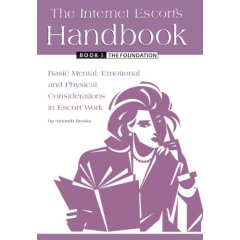
Click on cover to buy this book from Amazon.com
Amanda Brooks
$24.95 (soft cover)
Golden Girl Press, 2006
Review by Todd Morrison

The first in a series of handbooks devoted to outlining basic “mental, emotional, and physical considerations in escort work,” Brooks offers a provocative and well-written account of the myriad issues that need to be considered when contemplating involvement in this profession. The issues presented range from the serious (e.g., how to safeguard against sexually transmitted infections) to the more trivial (e.g., the importance of having soft skin, with an accompanying recipe for home-made body scrub – p. 75). However, from the vantage of the casual reader as well as those using the handbook as a “how-to” guide, even the seemingly trivial topics raised by Brooks are fascinating because they underscore the sheer number of elements that need to be considered when one works as an escort.
There are several strengths to the Handbook that warrant mention. First, Brooks is careful to frame the advice she offers within the parameters of her own experience and the escorts she has interviewed or known personally. She states this bias explicitly: “The scope of this series is limited. I’m speaking from the perspective of a female escort in the U.S. whose clientele is heterosexual men” (p. 5). Thus, faulty generalizations are avoided (i.e., what worked for Brooks may or may not work for the reader wishing to become an escort.) Second, Brooks has written the Handbook in a conversational style that is highly appealing; a style, one might add, that is difficult to implement effectively. The authorial tone used throughout is chatty, yet astute, and informative, without being dull. Third, as Brooks mentions in the Introduction, she is operating from the assumption that the reader has “only the barest idea of what [escorting] is all about” (pp. 5-6) and, thus, is careful to explain key terms and concepts. As a reader, I particularly valued the sections devoted to definitions (pp. 18-28; 119-132).
There are a few minor limitations that should be noted, ones the author may want to address in subsequent editions of the Handbook. First, the demonizing of “common” (i.e., street-based) prostitutes could have been avoided, without compromising the value of the book. For example, in relation to hairstyles, Brooks notes, “An escort with hair that looks anything like the hair on street prostitutes probably should think about a different style” (p. 74). Similarly, in relation to escorts being concerned that they may be hassled if they carry condoms in their purse or suitcase, Brooks remarks: “… start preaching …about safer sex, preparedness, and your power over your own body as an independent woman. That should shut them up. After all, you don’t look like a common prostitute, do you?” (p. 144). Second, the author’s comments about male clients serve to reinforce a rather traditional view of the sexes. Not all men are interested in the stats of pro athletes (p. 63) and, surely, there are some men who do not find women’s hair most appealing when it’s “spread on the pillow under [them]” (p. 72). Just as Brooks noted that her experiences may or may not be applicable to others so, too, should she provide similar qualifications on the part of clients.
Overall, I found the Internet Escort’s Handbook to be both informative and interesting. In addition to its targeted reader, I believe this book would serve as a useful resource for instructors in human sexuality and for those offering more specialized courses on the adult industry and/or women and work.